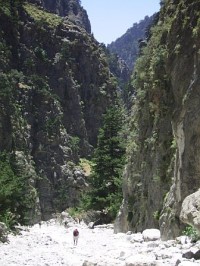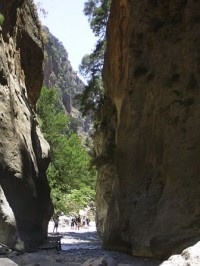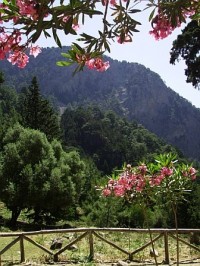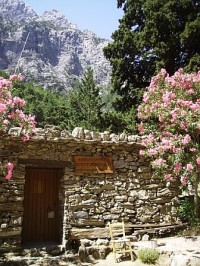Towering rock walls rise a thousand feet. A creek rattles against the rocks, slipping down from the mountains toward the distant ocean. The drama of Crete’s Samaria Gorge, which runs ten miles before emptying into the Libyan Sea, comes from its epic proportions. Samaria is reportedly the longest gorge in Europe, which at its  highest point rises 1,600 feet and narrows to only 11 feet. We had heard rumors of its rigor, and were determined to see whether a country known for classical civilization could provide an authentic wilderness experience.
highest point rises 1,600 feet and narrows to only 11 feet. We had heard rumors of its rigor, and were determined to see whether a country known for classical civilization could provide an authentic wilderness experience.
 Like most trekkers, we based ourselves in the city of Hania. Three buses depart early each morning for Samaria; we snagged the last two seats (€6.20 each). Hikers flock to the gorge for its stunning views and rare wildlife. The endemic kri-kri, a rare wild goat, haunts the valley; fear of its extinction provided the catalyst for creating Samaria Gorge National Park. But with crowds trekking through, it seemed unlikely that anyone except the very lucky would actually glimpse a kri-kri.
Like most trekkers, we based ourselves in the city of Hania. Three buses depart early each morning for Samaria; we snagged the last two seats (€6.20 each). Hikers flock to the gorge for its stunning views and rare wildlife. The endemic kri-kri, a rare wild goat, haunts the valley; fear of its extinction provided the catalyst for creating Samaria Gorge National Park. But with crowds trekking through, it seemed unlikely that anyone except the very lucky would actually glimpse a kri-kri.
 Our bus rose from the coast into the hills. Crete is the largest of the Greek islands, and topographically one of the wildest. Cretans have farmed the mountain plateaus for thousands of years. We wound through the pretty town of Lakki, no more than a few homes hugging the roadside and a whitewashed church.
Our bus rose from the coast into the hills. Crete is the largest of the Greek islands, and topographically one of the wildest. Cretans have farmed the mountain plateaus for thousands of years. We wound through the pretty town of Lakki, no more than a few homes hugging the roadside and a whitewashed church.
After 1.5 hours, we arrived in the village of Xyloskalo. Package tour buses dumped bewildered crowds at the park gates (€5.00 entrance fee). Porters on donkeys patrol this area and assist unprepared tourists who cannot complete the hike.
 The trail descended steeply at first, through pine-forested switchbacks, before dropping into a gently sloping plain. Sunlight broke through the pines and scattered on the trail. We rock-hopped a few creeks and leveled out in a wide valley rimmed by cliffs. Because this area had been settled for thousands of years before it became a national park in 1962, Samaria Gorge lacks the wildness that Americans might expect. Instead, it offers a unique opportunity to see human interaction with the landscape. We lunched in the abandoned village of Samaria, a cluster of stone buildings whose residents were relocated to create the park. Sitting under an olive tree, watching bees poke inside the blossoming bougainvillea, we were both in and outside of the wild.
The trail descended steeply at first, through pine-forested switchbacks, before dropping into a gently sloping plain. Sunlight broke through the pines and scattered on the trail. We rock-hopped a few creeks and leveled out in a wide valley rimmed by cliffs. Because this area had been settled for thousands of years before it became a national park in 1962, Samaria Gorge lacks the wildness that Americans might expect. Instead, it offers a unique opportunity to see human interaction with the landscape. We lunched in the abandoned village of Samaria, a cluster of stone buildings whose residents were relocated to create the park. Sitting under an olive tree, watching bees poke inside the blossoming bougainvillea, we were both in and outside of the wild.
 From Samaria, the gorge narrowed. High walls, striated with reds and grays, slowly closed around us. We followed the river to the Iron Gates, the narrowest section of the gorge. A rickety bridge, a few inches above the water, led us through the crevasse.
From Samaria, the gorge narrowed. High walls, striated with reds and grays, slowly closed around us. We followed the river to the Iron Gates, the narrowest section of the gorge. A rickety bridge, a few inches above the water, led us through the crevasse.
Like all good stories, this one ends at the sea. Samaria Gorge widens again at the beach town of Agia Roumeli. We had been trudging for five hours, but at the sight of the ocean, we untied our boots and dove in. A ferry takes weary hikers down the coast to Hora Sfakion, where they can catch a bus back to Hania (ferry €7.50). As we waited for the boat, we ate ice cream and dipped our toes in the Libyan Sea. Untamed Crete? Perhaps not. But Samaria Gorge had been conquered.


Comments